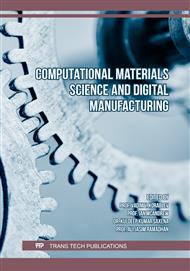p.13
p.41
p.51
p.61
p.69
p.77
p.83
p.89
p.99
Theoretical and Experimental Study on Wear Behavior in Order to the Improvement of Die Geometry in the Radial Forging Machine
Abstract:
Deformation of shafts and seamless tubes are carried out by a radial forging machine in order to achieve the required dimensions and improve the mechanical parameters of the material. Hence, the study of improving the performance of the radial machine leads to an increase in the quality of the forged tube, while the machine equipment in the process of radial forging will have the least erosion. In this process, the workpiece is surrounded by four tools and during the repeated blows of the die, the desired dimensions of the workpiece are obtained. with regards to the contact surface of the die with the workpiece, the most common tool that faces the highest erosion is the die. Therefore, the improvement of die geometry in order to minimize wear has been investigated in this article. Also, the distribution of die temperature and analysis of die stress during the process has been implemented. Accordingly, three types of die geometries: Flat, Concave and Convex are considered to measure the depth of wear and determine the maximum erosion through 3D finite element simulation and experimental estimates. Therefore, according to the comparison between numerical and analytical results in the case of wear analysis with experimental results, the validation of simulation was confirmed.
Info:
Periodical:
Pages:
69-75
Citation:
Online since:
April 2023
Authors:
Price:
Сopyright:
© 2023 Trans Tech Publications Ltd. All Rights Reserved
Share:
Citation:


